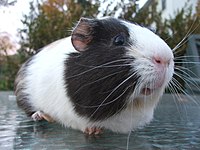
Photo from wikipedia
Historically, vaccination with Coxiella burnetii whole cell vaccines has induced hypersensitivity reactions in humans and animals that have had prior exposure to the pathogen as a result of infection or… Click to show full abstract
Historically, vaccination with Coxiella burnetii whole cell vaccines has induced hypersensitivity reactions in humans and animals that have had prior exposure to the pathogen as a result of infection or vaccination. Intradermal skin testing is routinely used to evaluate exposure in humans, and guinea pig hypersensitivity models have been developed to characterize the potential for reactogenicity in vaccine candidates. Here we describe a refinement of the guinea pig model using an alternate vaccine for positive controls. An initial comparative study used viable C. burnetii to compare the routes of sensitizing exposure of guinea pigs (intranasal vs intraperitoneal), evaluation of two time points for antigen challenge (21 and 42 days) and an assessment of two routes (intradermal and subcutaneous) of challenge using the ruminant vaccine Coxevac as the antigenic control. Animals sensitized by intraperitoneal exposure exhibited slightly larger gross reactions than did those sensitized by intranasal exposure, and reactions were more pronounced when skin challenge was performed at 42 days compared to 21 days post-sensitization. The intradermal route proved to be the optimal route of reactogenicity challenge. Histopathological changes at injection sites were similar to those previously reported and a scoring system was developed to compare reactions between groups receiving vaccine by intradermal versus subcutaneous routes. Based on the comparative study, a standardized protocol for assessment of vaccine reactogenicity in intranasally-sensitized animals was tested in a larger confirmatory study. Results suggest that screens utilizing a group size of n = 3 would achieve 90% power for detecting exposure-related reactogenic responses of the magnitude induced by Coxevac using either of two outcome measures.
Journal Title: PLoS ONE
Year Published: 2018
Link to full text (if available)
Share on Social Media: Sign Up to like & get
recommendations!